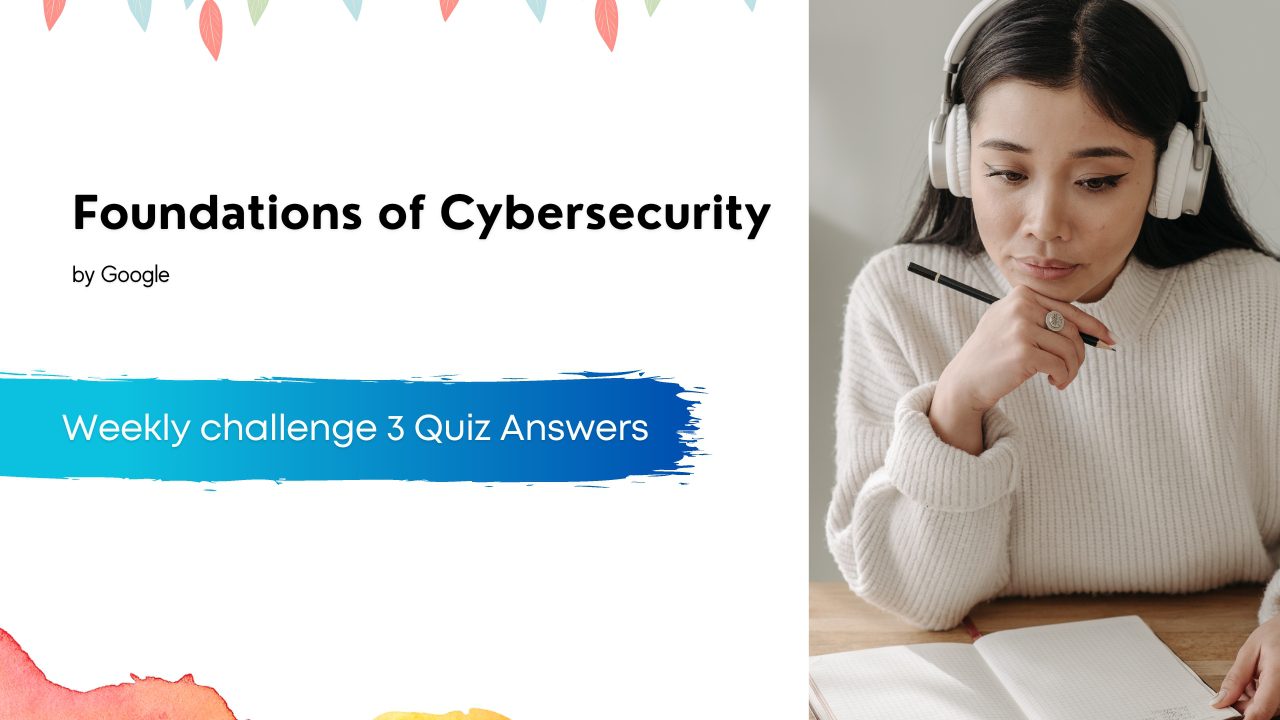Foundations of Cybersecurity Weekly challenge 3 Quiz Answers
Hello Friends in this article i am gone to share Foundations of Cybersecurity Weekly challenge 3 Quiz Answers with you..
Enroll Link: Foundations of Cybersecurity
Also Visit: Foundations of Cybersecurity Weekly challenge 2 Quiz Answers
Foundations of Cybersecurity Weekly challenge 3 Quiz Answers
Question 1)
What are some of the primary purposes of security frameworks? Select three answers.
- Safeguarding specific individuals
- Identifying security weaknesses
- Aligning security with business goals
- Securing financial information
Question 2)
Which of the following are core components of security frameworks? Select two answers.
- Monitoring and communicating results
- Implementing security processes
- Managing data requests
- Establishing regulatory compliance measures
Question 3)
Fill in the blank: A security professional implements encryption and multi-factor authentication (MFA) to better protect customers’ private data. This is an example of using _____.
- networking regulations
- security controls
- organizational upgrades
- security teams
Question 4)
You are helping your security team consider risk when setting up a new software system. Using the CIA triad, you focus on integrity, availability, and what else?
- Confidentiality
- Communication
- Conformity
- Consent
Question 5)
Fill in the blank: _____ are items perceived as having value to an organization.
- Alerts
- Incidents
- Lifecycles
- Assets
Question 6)
Which of the following statements accurately describe the NIST CSF? Select all that apply.
- Security teams use it as a baseline to manage risk.
- It is only effective at managing long-term risk.
- It consists of standards, guidelines, and best practices.
- Its purpose is to help manage cybersecurity risk.
Question 7)
Fill in the blank: As a security professional, you monitor the potential threats associated with _____ because they often have access to sensitive information, know where to find it, and may have malicious intent.
- external vendors
- disgruntled employees
- existing customers
- governing agencies
Question 8)
A security professional working at a bank is running late for a meeting. They consider saving time by leaving files on their desk that contain client account numbers. However, after thinking about company guidelines with regards to compliance, the security professional takes the time to properly store the files. Which concept does this scenario describe?
- Security controls
- Security ethics
- Public finance
- Preserving evidence
Question 9)
Fill in the blank: The ethical principle of _____ involves safeguarding a company database that contains sensitive information about employees.
- honesty
- unrestricted access
- privacy protection
- non-bias
Question 10)
You are a security professional working for a state motor vehicle agency that stores drivers’ national identification numbers and banking information. Which ethical principle involves adhering to rules that are intended to protect these types of data?
- Guidelines
- Restrictions
- Laws
- Investigations
Question 11)
Fill in the blank: A security professional has been tasked with implementing strict password policies on workstations to reduce the risk of password theft. This is an example of _____.
hardware changes- security controls
- security teams
- networking regulations
Question 12)
You are helping your security team consider risk when setting up a new software system. Using the CIA triad, you focus on confidentiality, availability, and what else?
- Inconsistencies
- Integrity
- Intelligence
- Information
Question 13)
Fill in the blank: A key aspect of the CIA triad is ensuring that only _____ can access specific assets.
- business competitors
- internet providers
- social media sites
- authorized users
Question 14)
Fill in the blank: The ethical principle of _____ involves safeguarding an organization’s human resources records that contain personal details about employees.
- honesty
- privacy protection
- unlimited access
- non-bias
Question 15)
Which ethical principle describes the rules that are recognized by a community and enforced by a governing entity?
- Guidelines
- Laws
- Protections
- Restrictions
Question 16)
Fill in the blank: A security professional has been tasked with implementing safeguards to reduce suspicious activity on their company’s network. They use _____ to help them reduce this type of risk.
- security controls
- private information
- security ethics
- public websites
Question 17)
Fill in the blank: Some of the most dangerous threat actors are _____ because they often know where to find sensitive information, can access it, and may have malicious intent.
- disgruntled employees
- dissatisfied customers
- senior partners
- past vendors
Question 18)
A security professional is updating software on a coworker’s computer and happens to see a very interesting email about another employee. The security professional chooses to follow company guidelines with regards to privacy protections and does not share the information with coworkers. Which concept does this scenario describe?
- Security controls
- Preserving evidence
- Business email compromise
- Security ethics
Question 19)
Which ethical principle describes safeguarding personal information from unauthorized use?
- Privacy protection
- Honesty
- Non-bias
- Incident investigation
Question 20)
Fill in the blank: The ethical principle of _____ involves adhering to compliance regulations.
- protections
- laws
- restrictions
- guidelines
Question 21)
A security professional overhears two employees discussing an exciting new product that has not been announced to the public. The security professional chooses to follow company guidelines with regards to confidentiality and does not share the information about the new product with friends. Which concept does this scenario describe?
- Security ethics
- Data encryption
- Security controls
- Preserving evidence
Question 22)
Which of the following are core components of security frameworks? Select two answers.
- Implementing security processes
- Setting guidelines to achieve security goals
- Monitoring personally identifiable information
- Establishing regulatory compliance measures

